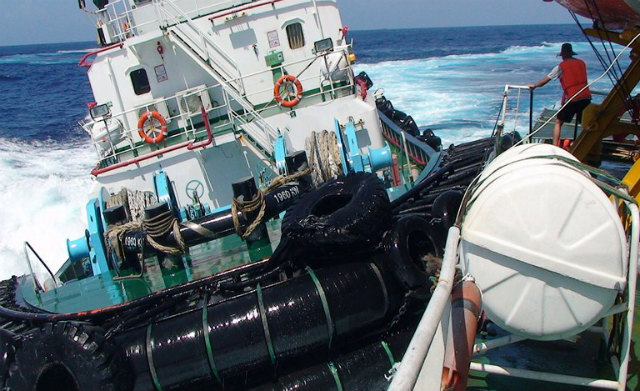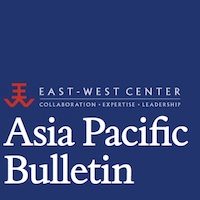SUMMARY
This is AI generated summarization, which may have errors. For context, always refer to the full article.

Last October, during a visit by Chinese Premier Li Keqiang, Vietnam Prime Minister Nguyen Tan Dung promised to buttress “political trust” between the two South China Sea (SCS) claimants. Last week, while I was speaking at a conference in Da Nang,  Vietnam where the Chinese were visibly absent, verbal accusations were flying both on land and in the media. The proximate cause of tensions is the placement of Haiyang Shiyou 981 (HS-981) deep-sea drilling platform inside Vietnam’s 200-nautical-mile exclusive economic zone.
Vietnam where the Chinese were visibly absent, verbal accusations were flying both on land and in the media. The proximate cause of tensions is the placement of Haiyang Shiyou 981 (HS-981) deep-sea drilling platform inside Vietnam’s 200-nautical-mile exclusive economic zone.
Since that unilateral maneuver in early May, China has created a cordon sanitaire around the rig by deploying military, coast guard, and fishing vessels in three concentric patrol circles. To date, a Vietnamese fishing vessel has been sunk and China has made unsubstantiated claims that Vietnamese boats have hit Chinese vessels on more than 1,400 occasions. Dueling videos are currently on the internet.
While Vietnamese behavior is not beyond reproach, China might have a better case to make if it would adhere to international law. China has every right to protect a drilling rig inside its territorial waters, but a rig outside of its 12-nautical-mile territorial waters is entitled to only a 500-meter safety zone. But the Chinese are apparently seeking to establish more imperious ends. HS-981 is within China’s 9-dashed line that covers some 80 percent of the SCS. The Chinese hesitate to articulate this because an assertion of historical claims has no basis under the United Nations Convention on the Law of the Sea (UNCLOS). Indeed, the Philippines is pursuing international arbitration to help clarify this important point. Beijing is opportunistically seeking to flex its newfound muscle and make the 9-dash line a de facto and de jure reality. In effect, China wants the South (and East) China Sea as an inland lake.
The placement of HS-981 is part of a disturbing pattern of aggressive Chinese behavior. Another ongoing resort to “tailored coercion” is the reclamation of small land features in the Spratly Islands. Recently released photographs taken in March show China’s reclamation of Johnson South Reef, the site of a 1988 Vietnam-China naval skirmish. Although China is not alone is seeking to advance its territorial claims and maritime interests, its behavior is uniquely escalatory. US Secretary of Defense Chuck Hagel singled out China’s “destabilizing, unilateral actions” against its maritime neighbors at this year’s Shangri-La Dialogue in Singapore.
The placement of HS-981, coming after diplomatic exertions to improve Beijing-Hanoi ties, is perplexing to many in the region. But China’s gambit in its near seas involves dialing up and dialing down coercive diplomacy. As part of a renewed focus on “periphery diplomacy,” China is rewarding neighbors willing to work with Beijing, and is seeking to isolate those who resist China’s unilateral demands. Such actions are tailored to be sufficiently peaceful so as not to escalate into full-fledged conflict or to trigger a unified, anti-China alliance; they are tailored to appear sufficiently non-military in nature and thus not intended to accentuate China’s rapidly modernizing military forces; and they are tailored to send varying messages to different audiences–internal, regional, and international.
China’s tailored coercion is aimed not just at its neighbors but also at the United States. China wants to coerce the United States to tamp down the national exuberance of its allies and partners, from the Philippines and Japan (in the East China Sea), to Vietnam and Malaysia. Notwithstanding China’s coercive behavior, the United States needs to persevere in building an open, rules-based system in the Asia-Pacific region. But in the meantime, it also needs to find a way to address Chinese incremental aggression, often likened to salami slicing. In the present SCS crisis, the United States needs to bolster its ties with Vietnam to help impose costs on China. Taking together the twin US goals of regional security maintenance and order building, and focusing on countering China’s use of coercion to unilaterally alter the status quo, there are five priorities that deserve attention from both Hanoi and Washington, and the region in general.
First, as part of the burgeoning US-Vietnam security dialogue, the two countries should focus on developing cost-imposition strategies that might dissuade China from resorting to unilateral changes to the status quo or impose stiff penalties for bad behavior. Cost-imposition strategies can be direct and indirect, military and non-military, short-term and long-term. But they should be feasible, cost-effective, and meaningful. Vietnam needs to send top-level officials to Washington to underscore the importance of this dialogue.
Second, there should be more frequent and larger bilateral exercises and US military deployments to Vietnam under the existing shared membership in the Proliferation Security Initiative (PSI). Through PSI, the United States can provide a reassuring presence without taking on the burdens, costs and risks of trying to restore a permanent military base. At the same time, greater US-Vietnam cooperation can improve the professionalism of Vietnamese defenses and the capacity for combined action. Improving maritime domain awareness is an objective that supports both PSI and would have benefits for the early detection of misbehavior in the East Sea.
Third, the United States should support triangular dialogue and practical cooperation among other SCS claimant states, especially Vietnam, Malaysia and the Philippines. The United States can support this dialogue through regional multilateral forums such as the ASEAN Regional Forum, the ASEAN Defense Ministers’ Meeting Plus and the East Asia Summit. Washington can also encourage other US allies and partners (Japan, South Korea, Australia, India and other members of ASEAN) to offer assistance with training and education, equipment and information sharing. The United States should encourage Japan, which is already providing coast guard patrol vessels beginning next year, and India, which operates Russian submarines, to assist the Vietnamese navy to operate and deploy Russian Kilo-class submarines. As Vietnam incorporates six submarines into its small navy, others need to help Vietnam establish operational independence.
Fourth, the United States should end the ban on lethal arms sales to Vietnam. The scope and kind of direct military support can still be linked to demonstrable improvements in human rights. But it is now time to begin limited arms sales that are useful for countering tailored coercion. Such systems could improve maritime domain awareness and bolster defensive if still potentially lethal means of punishing any attacker. Torpedoes and short-range cruise missiles would strengthen deterrence, and a potential aggressor would think twice before using overt coercion or limited force to make its claims.
Fifth, the United States should press Vietnam and other ASEAN members to support specific rules for maintaining good order at sea and preserve the freedom of the global commons in the South China Sea. Specific steps that might eventually be part of a binding code of conduct should be promoted and put into practice as soon as possible. International arbitration over UNCLOS provisions should be embraced. Land features should be systematically cataloged and defined to develop a shared regional understanding of what land features are islands and which are rocks.
These steps are illustrative of a broader tool kit at the disposal of officials in Vietnam, the United States and the region to impose costs on bad behavior and provide safeguards for complying with mutually agreed rules. They are necessary because of China’s increasing reliance on coercion. At the same time, it is vital to further develop a roadmap with China on how to avert dangerous incidents and manage strategic competition. Through these steps, tailored coercion can be prevented from becoming the accepted norm in the South China Sea.
About the Author
Dr. Patrick M. Cronin is Senior Director of the Asia-Pacific Security Program at the Center for a New American Security. He can be contacted via email at pcronin@cnas.org. This piece was first published 26 June 2014.
The views expressed here are solely those of the author and not of any organization with which the author is affiliated.
The Asia Pacific Bulletin (APB) is produced by the East-West Center in Washington DC, designed to capture the essence of dialogue and debate on issues of concern in US-Asia relations. For comments/responses on APB issues or article submissions, please contact washington@eastwestcenter.org.
Add a comment
How does this make you feel?
There are no comments yet. Add your comment to start the conversation.